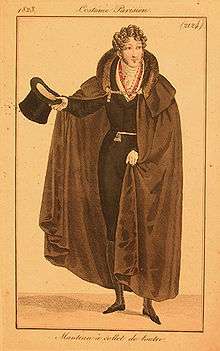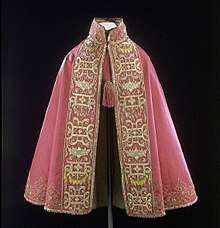Cloak
A cloak is a type of loose garment that is worn over indoor clothing and serves the same purpose as an overcoat; it protects the wearer from the cold, rain or wind for example, or it may form part of a fashionable outfit or uniform.[1] Cloaks have been used by myriad historic societies; many climates favor wearing a full-body garment which is easily removed and does not constrain the wearer with sleeves. Over time cloak designs have been changed to match fashion and available textiles.[2]


Cloaks generally fasten at the neck or over the shoulder, vary in length, from hip all the way down to the ankle, mid-calf being the normal length. They may have an attached hood and may cover and fasten down the front, in which case they have holes or slits for the hands to pass through. However, cloaks are almost always sleeveless.
Etymology
The word cloak comes from Old North French cloque (Old French cloche, cloke) meaning "travelling cloak", from Medieval Latin clocca "travelers' cape," literally "a bell," so called from the garment's bell-like shape. Thus the word is related to the word clock.[3]
History
Ancient Greeks and Romans were known to wear cloaks. Greek men and women wore the himation, from the Archaic through the Hellenistic periods (c. 750-30 BC).[4] Romans would later wear the Greek-styled cloak, the pallium. The pallium was quadrangular, shaped like a square,[5] and sat on the shoulders, not unlike the himation.
Romans of the Republic would wear the toga as a formal display of their citizenship. It was denied to foreigners[6] and was worn by magistrates on all occasions as a badge of office. The toga was claimed to have originated with Numa Pompilius, the second king of Rome.[7]
Opera cloak
In full evening dress in the Western countries, ladies and gentlemen frequently use the cloak as a fashion statement, or to protect the fine fabrics of evening wear from the elements, especially where a coat would crush or hide the garment. Opera cloaks are made of quality materials such as wool or cashmere, velvet and satin.
Ladies may wear a long (over the shoulders or to ankles) cloak usually called a cape, or a full-length cloak. Gentlemen wear an ankle-length or full-length cloak. Formal cloaks often have expensive, colored linings and trimmings such as silk, satin, velvet and fur.
The term was the title of a 1942 operatic comedy.[8]
In literature and the arts

According to the King James Version of the Bible, Matthew recorded Jesus of Galilee saying in Matthew 5:40: "And if any man will sue thee at the law, and take away thy coat, let him have thy cloke also." The King James Version of the Bible has the words recorded a little differently in Luke 6:29: "...and him that taketh away thy cloke, forbid not to take thy coat also."
Cloaks are a staple garment in the fantasy genre due to the popularity of medieval settings, although fantasy cloak designs normally have more resemblance to 18th or 19th-century cloaks rather than medieval ones. They are also usually associated with witches, wizards, and vampires; the best-known stage version of Dracula, which first made actor Bela Lugosi prominent, featured him wearing it so that his exit through a trap door concealed on the stage could seem sudden. When Lugosi reprised his role as Dracula for the 1931 Universal Studios motion picture version of the play, he retained the cloak as part of his outfit, which made such a strong impression that cloaks came to be equated with Count Dracula in nearly all non-historical media depictions of him.
Fantasy cloaks are often magical. For example, they may grant the person wearing it invisibility as in the Harry Potter series by J. K. Rowling. A similar sort of garment is worn by the members of the Fellowship of the Ring in The Lord of the Rings by J. R. R. Tolkien, although instead of granting complete invisibility, the Elf-made cloaks simply appear to shift between any natural color (e.g. green, gray, brown) to help the wearer to blend in with his or her surroundings. In the Marvel comic book stories and in the Marvel Cinematic Universe, the sorcerer Doctor Strange is associated with a magical Cloak of Levitation, which not only enables its wearer to levitate, but has other mystical abilities as well. Doctor Strange also uses it as a weapon. Alternatively, cloaks in fantasy may nullify magical projectiles, as the "cloak of magic resistance" in NetHack. In Greek mythology, the magical hide armor that Hercules made for himself from the skin of the Nemean Lion, at the end of Hercules' first labor, might also be seen as an early idea of a magical cloak.[9] This latter was notable because it was said to be impervious to all cutting and impact weapons.
Metaphor
Figuratively, a cloak may be anything that disguises or conceals something. In many science fiction franchises, such as Star Trek, there are cloaking devices, which provide a way to avoid detection by making objects appear invisible. A real device, albeit of limited capability, was demonstrated in 2006.[10]
Because they keep a person hidden and conceal a weapon, the phrase cloak and dagger has come to refer to espionage[11] and secretive crimes: it suggests murder from hidden sources. "Cloak and dagger" stories are thus mystery, detective, and crime stories of this. The vigilante duo of Marvel comics Cloak and Dagger[12] is a reference to this.
See also
| Wikimedia Commons has media related to Cloaks. |
- Cape
- Chlamys, the ancient and Byzantine Greek cloak
- Cloaking device
- Mantle (clothing)
- Poncho
- Robe
- Serape
- Shawl
- Shroud
- Stole
- Veil
- Kinsale cloak
- Fibula (brooch), a brooch or pin for fastening garments, such as cloaks, typically at the right shoulder
References
- Bernadine Morris (March 31, 1981). "Italian fashion's success: a fresh point of view". The New York Times.
a simple wrap .. extra layer of protection from the elements
- Bess Liebenson (February 24, 1991). "Changing Shapes of Clothes: Little for Men, Lots for Women". The New York Times.
- "cloak - Origin and meaning of cloak by Online Etymology Dictionary". www.etymonline.com.
- "Himation - clothing".
- Tertullian, De Pallio, I
- Suetonius, Divus Claudius, XV
- William Smith, LLD; William Wayte; G. E. Marindin, eds. (1890). "Toga". A Dictionary of Greek and Roman Antiquities. London: John Murray.
- Olin Downes (November 4, 1942). "Double Bill Given by the New Opera: Damrosch's 'The Opera Cloak' Offered as Part of Program at Broadway Theatre". The New York Times. p. 26.
Damrosch's operatic comedy, "The Opera Cloak"
- John Caldwell (March 20, 1983). "Art: new acquisition at Atheneum". The New York Times.
Herc .. his lionskin cloak looks a little too ...
- John Schwartz (October 20, 2006). "Scientists Take Step Toward Invisibility". The New York Times.
- Philip Taubman (May 19, 1996). "Cloak and Dagger". The New York Times.
- "Cloak & Dagger". The New York Times. June 6, 2018.
... the comics company's .. live-action series
Sources
- Oxford English Dictionary
- Ashelford, Jane: The Art of Dress: Clothing and Society 1500-1914, Abrams, 1996. ISBN 0-8109-6317-5
- Baumgarten, Linda: What Clothes Reveal: The Language of Clothing in Colonial and Federal America, Yale University Press, 2016. ISBN 0-300-09580-5
- Payne, Blanche: History of Costume from the Stone Age to the Twentysecond Century, Harper & Row, 2965. No ISBN for this edition; ASIN B0006BMNFS
- Picken, Mary Brooks: The Fashion Dictionary, Funk and Bagnalls, 1957. (1973 edition ISBN 0-308-10052-2)
